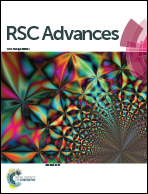A diols-responsive triple-component supra-amphiphile constructed from pillar[5]arene-based recognition†
Abstract
A triple-component supra-amphiphile WSP5⊃G1@A is constructed based on phenylboronic acid/diols dynamic covalent chemistry and water-soluble pillararenes/trimethylamine host–guest recognition. Diols-responsive self-assembly of this ternary supra-amphiphile is fully investigated in aqueous solution.
![Graphical abstract: A diols-responsive triple-component supra-amphiphile constructed from pillar[5]arene-based recognition](/en/Image/Get?imageInfo.ImageType=GA&imageInfo.ImageIdentifier.ManuscriptID=C6RA07216J&imageInfo.ImageIdentifier.Year=2016)

 Please wait while we load your content...
Please wait while we load your content...